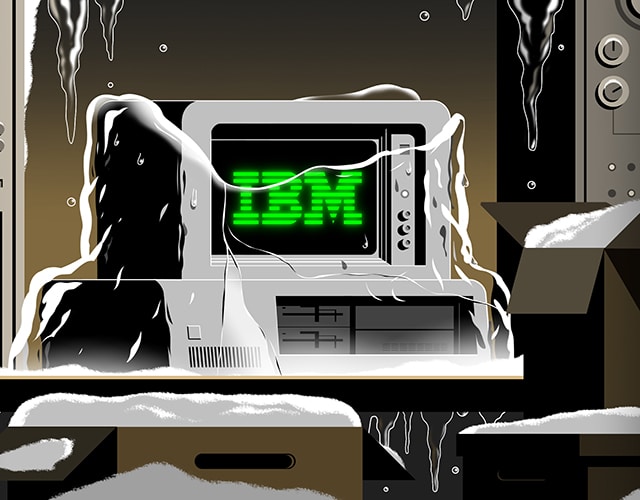Traditional pension plans haven’t come back. But the news from IBM might lead you to think so.
Last month, IBM thawed out a defined benefit pension plan that it had frozen more than 15 years ago. The company has also stopped making contributions into employee 401(k) accounts.
These moves are startling, because, on the surface, at least, IBM seems to be reversing a decadeslong trend of corporations moving away from traditional pension plans. With the old plans, companies promised to pay employees retirement income that rewarded them for long years of service. But these plans were expensive, and IBM and hundreds of other firms instead began to emphasize 401(k)s that moved the primary responsibility for saving and investing to workers.
Good for Some, Including Shareholders
IBM’s new approach is significant because the company has been a leader in employee benefit policymaking. What it is doing now is no simple return to the classic cradle-to-grave benefits system. In fact, IBM’s new pension plan isn’t nearly as generous to long-tenured employees compared with its predecessor.
The move has real advantages for some people who work at IBM, particularly those who put little or no money of their own into 401(k)s and who stay at the company for a relatively short while.
Crucially, IBM’s maneuver is likely to be wonderful for its shareholders. The company is saving hundreds of millions of dollars a year by stopping contributions to employee 401(k) accounts. And it doesn’t need to put any money into the pension plan this year — and, probably, for the next few years — because it has plenty of money already in it. On a purely financial standpoint, IBM is improving its cash flow and bottom line.
For a small but important subset of companies — those with fully funded, closed or frozen pension plans — IBM’s move could be a harbinger of things to come, pension consultants say. IBM is using a surplus in its pension fund to simultaneously change its employee benefits package and help the company’s finances.
“You’ll be seeing more of this,” said Matt Maloney, a senior partner at Aon. “But I don’t think it’s really a watershed event because not that many companies are in a position to do what IBM is doing.”
Retirement Basics
IBM calls its new pension plan a “retirement benefit account.” It is nestled, legally and bureaucratically, within the old version. Because it’s part of the defined benefit pension plan, the new plan is backed by the government’s Pension Benefit Guaranty Corp., which will pay benefits, up to certain limits, if the plan runs out of money or the employer goes out of business.
Unlike 401(k)s, in pension plans the employer makes “the contribution, owns the assets, selects the investments and bears the investment risk,” said Alicia Munnell, the director of the Center for Retirement Research at Boston College.
Employees are immediately vested in the new IBM plan, and can take their money with them when they leave, IBM says. So far, so good.
But for many employees, the change comes at a cost.
IBM will no longer make contributions to employee 401(k) plans. Until now, it made 5% matching contributions and 1% automatic contributions, according to internal documents that were posted publicly and whose authenticity Jessica Chen, an IBM spokeswoman, confirmed. That money and those accounts are owned by employees. It took a year for employees to be vested in those accounts.
The new retirement benefit accounts are part of a so-called cash balance plan, a pension plan in which the employer controls how the money is invested.
In the new IBM accounts, employees receive credits equal to 5% of their salary — 1 percentage point less than the company’s maximum contribution to the 401(k) used to be. For the first year only, employees are getting a 1% salary bump to make up for the discrepancy in contributions between the old 401(k) and the new retirement accounts.
Risk and Return
IBM documents show that in the new accounts, employees are guaranteed a return of 6% interest for the first three years — an excellent rate under current market conditions.
From 2027 through 2033, the return is likely to fall. Employees will receive the yield on 10-year Treasurys, with a floor of 3%. From 2034 on, there is no floor. So if Treasury yields fall below 3% — as they were most of the time from late 2008 through early 2022 — a paltry return is all that employees will get.
Remember, in a 401(k), employees are free to invest as they like. People with a long investing horizon can favor the stock market, which tends to produce higher returns than government bonds over long periods.
Although IBM workers can keep their 401(k)s and continue to add money to them, they won’t have the inducement of a company match. How many will continue to contribute remains to be seen. In the new accounts, employees are receiving only fixed-income investments.
That may be fine for people in retirement, but it’s questionable for those with years to come in the workforce. Employees may need to increase the equity allocations in their 401(k)s or other accounts.
The Background
At the peak for defined benefit plans, in the 1970s, as many as 62% of workers in the private sector were covered solely by these retirement plans, according to the Employee Benefit Research Institute, an independent organization that researches retirement issues.
By 2022, the institute found, only 1% of private-sector wage and salaried workers had just a defined benefit plan, while 41% participated in only a defined contribution — or 401(k) — plan, and 8% participated in both.
Underfunding of corporate pension plans led to the great shift away from defined benefit plans. At first, 401(k)s were supplementary savings vehicles for employees. Now, along with Social Security, 401(k)s have become core elements of retirement.
By closing the old defined benefit plans to new workers and by freezing benefits for people already enrolled in them, companies reduced their potential pension liabilities. They poured money into the old retirement plans to bring them into compliance with government rules, which were relaxed to give companies relief.
But canny management and cooperative financial markets have helped increase plan funding, too. Because pensions are a form of annuities, the increase in interest rates over the past couple of years has made it cheaper to finance existing pensions. On top of that, strong stock returns over the past decade have bolstered fund assets.
These factors have led to a sea change in the funding of the old corporate pension plans. (Public pension plans, on the other hand, face an estimated $1.45 trillion funding gap, according to the Pew Charitable Trusts.) For big companies, the average defined benefit private plan now has more than enough money to pay off its pension obligations. For defined benefit pension plans at S&P 500 companies, Aon says, funding levels rose to 102.7% on Feb. 6 from 78.4% in 2011.
The Bottom Line
IBM’s defined benefit pension plan is now extremely well funded. Its annual report shows that it had a $3.5 billion surplus in the plan last year, while it paid $550 million annually in 401(k) contributions. It doesn’t need to put fresh money into the pension plan and now, with the shift to the new retirement benefit accounts, it isn’t making 401(k) contributions either.
Munnell estimated that IBM would be able to credit employees with benefits in the new accounts for at least the next six or seven years. Several pension consultants said that if market conditions were favorable, and IBM invested the $3.5 billion surplus at a higher rate of return than the fixed-income rates it was offering employees, it might be able to avoid deploying any cash on these benefits for many years.
The company said its retirement innovation was improving its finances. In an earnings call on Jan. 24, James J. Kavanaugh, IBM’s chief financial officer, said the company’s cash flow was better this year, in part because of “lower cash requirements driven by changes in our retirement plans.” That could be true for years to come.
A Model for Others?
Other companies with frozen plans that are fully funded could follow IBM’s lead.
This isn’t a return to the richer benefits for long-tenured employees provided by traditional defined benefit plans.
But perhaps cash balance plans combined with 401(k)s are the best that most big companies are likely to be offering. If so, Zorast Wadia, a principal and consulting actuary at Milliman, the pension consultant, suggested, there are a variety of ways of designing retirement packages that make use of pension plan surpluses. Unlike IBM, for example, some companies could continue their 401(k) contributions while starting cash balance plans.
Finding ways to use well-funded pension plans generously but responsibly is a challenge for big companies. IBM has moved cautiously. But it’s in nobody’s interest for companies to make pension promises that they can’t keep.
c.2024 The New York Times Company. This article originally appeared in The New York Times.







